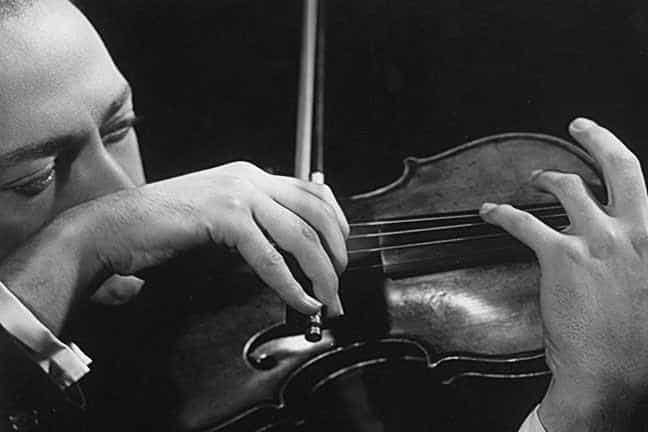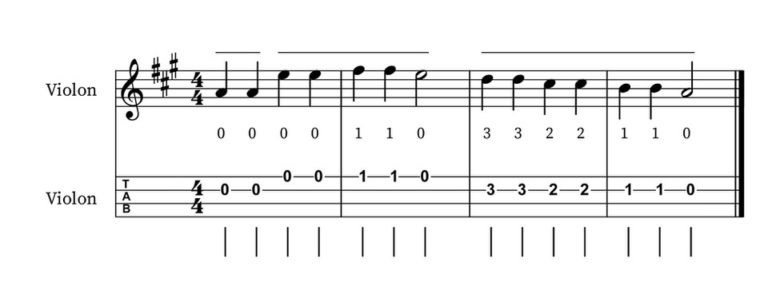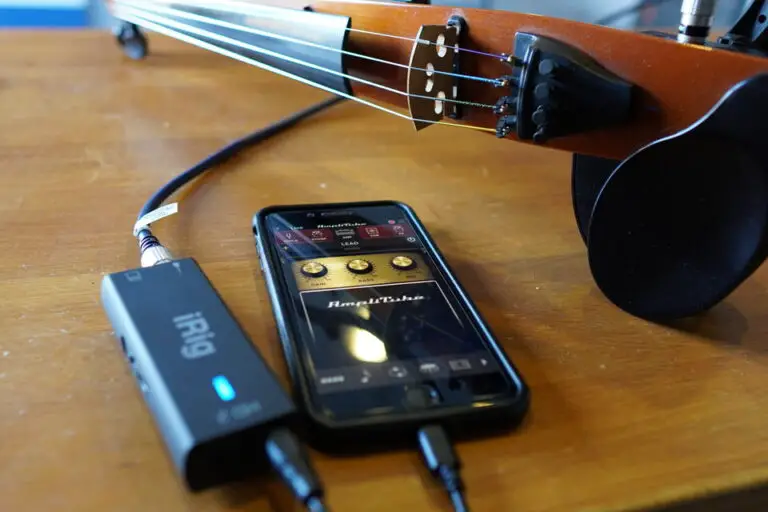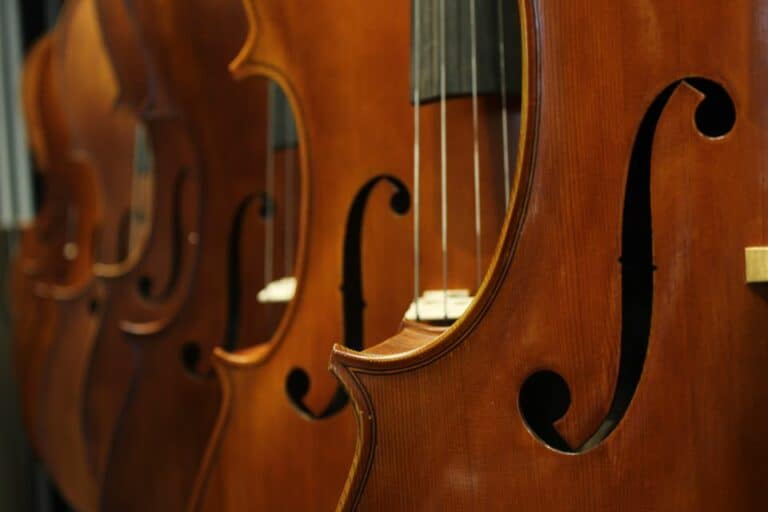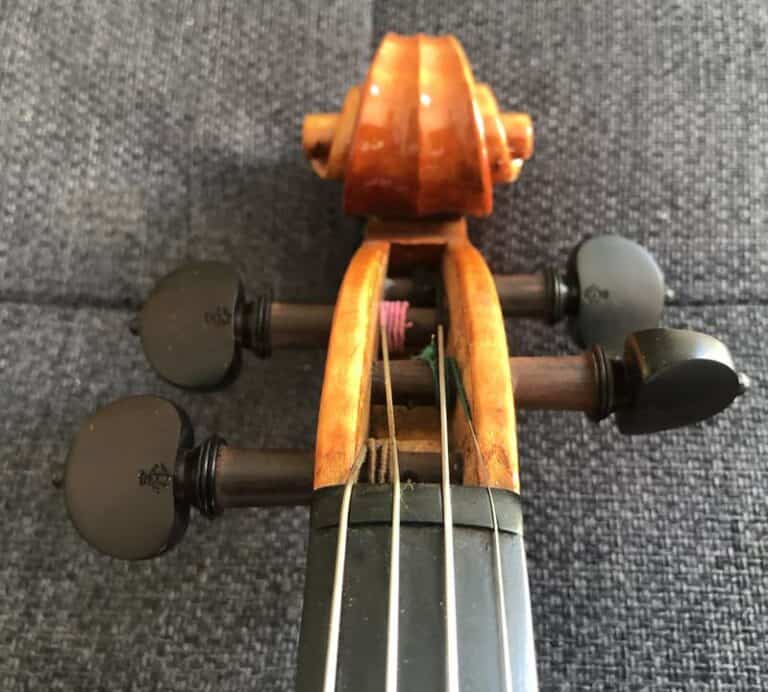What is an Electric Violin, a Silent Violin? Definitive FAQ
Everything you wanted to know about electric violins but were afraid to ask!
- What is an electric violin?
- Do electric violins sound good?
- Do electric violins need to be plugged in?
- How loud is an electric violin?
- What do you need to play an electric violin?
- Is an electric violin good for beginners?
- Is an electric violin a good first instrument?
- Why do electric violins have 5 strings?
- Do electric violins need special strings?
- Do you need rosin for an electric violin?
What is an electric violin or silent violin?
An electric violin is often called a “silent violin”. But it shouldn’t be so: it is a term invented by Yamaha to call their first line of electric violins: the “silent violin” series.
Many types of electric violins have some kind of resonance body, whether made of wood or carbon fiber. In that case, what is important is the pickup system that amplifies the instrument, which gives its name to the instrument. But it is not a “silent violin” neither by its name nor by its sound.
But as soon as a violin is amplified, there is no need for a resonance body. And as a wooden body is long, difficult, and expensive to make, many makers decided to cut it altogether. Electric violins were reduced to their simplest form: the neck and a minimalist body underneath the strings. Without a resonance body, the acoustic natural sound is almost inexistent, hence the name “silent violin”.
So, an electric violin is any kind of violin with a pickup, a silent violin is a violin made by Yamaha for their silent series.
But technically, any electric violin with a minimalist body is as silent as a Yamaha violin.
But let’s compare the sound:
Do electric violins sound good?
It is hard to make a generalization and answer such a question with a definitive answer. We can’t compare the sound of an acoustic violin with an electric one.
Unplugged
Unplugged electric violins sound thin, but it is good enough for practice. Their sound is high-pitched with little to no bass or medium frequencies, due to the lack of a resonance chamber. But as the volume is low, it is quite bearable. Sometimes, I find it more conformable to practice long hours with an unplugged electric violin rather than my loud acoustic violin. I do not always play with a good, well-made, electric sound with reverb and delay; even if it can be really satisfying to hear oneself in a private never-ending concert-like sound… But it is somehow too much forgiving!
Plugged
A plugged electric violin can sound better than an acoustic one, especially if the violinist is lacking technique. But it won’t make miracles. If you can’t bow straight and produce some kind of ok sound, your electric violin won’t transform you into a rock star from day one, even with a lot of effects.
Let’s say that to produce sound on a violin, there is a particular technique: I have described it in that long blog post. You need to balance the speed of the bow with the downward pressure of your right arm while choosing the right contact place on the string. You need to improve that technique on a classical violin. But if you don’t master it yet, an electric violin will be much more forgiving. You can play softly to avoid scratches and squeaks, and your violin will amplify your sound at will. Add some effects, and they will mitigate the defects of your sound in a positive way.
So an electric violin can sound well, depending on the amp, effects, and/or sound system. But, as always, a good violin, such as the Yamaha SV200, or SV250 will sound better than a sub $300 Stagg electric violin (check current prices on Amazon). The professional Yamaha series have two microphones: one in the bridge and one in the body. This gives a perfect blend of sound: you can choose the bridge pickup for a more thin and bright direct sound, or the fuller and more acoustic-like body mike.
So yes, an electric violin can sound good; but it will be nowhere near a good acoustic violin. But they serve different purposes and shouldn’t be strictly compared. Only the best and more expensive electric violins have a sound that can be compared to a loud acoustic violin. The structure and design of an electric violin tend to amplify the noise of the bow: the natural scratchy sound of the bow near to the bridge, a sound that naturally disappears in a room when played acoustically. That edge to the sound can be acceptable when compared to a rock guitar with saturation but can be detrimental in an acoustic-like band.
Do electric violins need to be plugged in?
No, an electric violin doesn’t need to be plugged in to be played. Especially if it has a kind of body (carbon fiber or even wood), in that case, it can be considered as an electro-acoustic instrument.
You can play and practice your electric violin without plugging it. The sound is not loud and is missing lows and middles, but is perfectly playable. I personally find it refreshing and relaxing to practice with my unplugged Yamaha SV100. The sound is so soft: it is agreeable to practice scales and arpeggios like that.
I used to always travel with headphones to practice, but now I often prefer to practice unplugged for hours. When I go to a gig, I then plug my violin into the sound system through a preamp (SansAmp).
I have recorded a bit of music where I compared an unplugged electric violin and my acoustic one. Here is the difference:
How loud is an electric violin?
I have described in detail in that blog post the difference in volume between an electric violin and an acoustic one. But in a nutshell, an electric violin has a soft sound that is not heard from another room. The high-pitched e-string is more heard than the low G string that really needs more wood to vibrate and project.
But soft high-pitched sounds don’t go through walls: you won’t disturb your neighbors at home or in a hotel, let alone in the next condominium or house. You won’t be heard.
If we talk about how loud it can be when plugged in, it will depend on your amplification, of course; but a solid-body violin (as an electric guitar) will go pretty loud without feedback. It can be compared to an electric guitar; you definitely play in a stadium if you were to become the next Jimi Hendrix of the violin.
Yamaha silent violins have an output of around 60 dBa when unplugged, which is compared to 70 dBa for an acoustic violin with a mute, up to 90 dBa when a classical violinist plays in concert.
In a nutshell, a solid-body electric violin can be really soft to really loud, depending on the sound system or the lack thereof.
What do you need to play an electric violin?
To play an electric violin, you need:
- a bow,
- some rosin,
- headphones,
- an amp,
- a shoulder rest,
- a chin rest
Then, for a complete set, you can add:
- a violin case,
- a tuner
The better the instrument, the less likely it is sold with a bow. But, in any case, pun non intended, you need a bow to play your instrument. It is a regular bow: there is no such thing as a bow made for electric violins. Whether bought together with your violin or separately, your bow needs rosin (see below) to produce sound on your instrument.
Then, you can play your violin plugged (see above), but after a while, you will want to hear everything that your instrument is capable of. Then, either you use headphones or an amp.
Headphones
Most electric violins have a headphones 1/8′ jack input cable. It is the case for the Yamaha SV 100 series. The SV 200 has an electronic box in which you can plug headphones.
For violins that do not provide input, nor an electronic box, you still can use a digital audio interface, where you can plug your headphones. The iRig HD2 is the easier choice here, as it works painlessly and is quite cheap. I have tested it in that blog post and I described what to do to plug your electric violin into your Macbook.
Amp
If you want to play with a band, or for yourself or friends, an electric instrument is usually plugged into an amp. There are many types of amps; some are more dedicated to acoustic sounds, others to electric and modern music with integrated effects. One that I use and recommend is not the cheapest, but is easy to use, is the Yamaha THR 10 (here on Amazon). It sounds great and provides several effects and amp simulations. You can add reverb, delay, drive, saturation… You can get a satisfying sound quite easily. But do not choose the THR5 as you will be deceived: it is not designed to amplify the high frequencies of a violin and will sound harsh.
Chinrest and shoulder rest
As an electric violin has a special shape, it is often provided with its own specially made should-rest and/or shoulder rest. It is the case with many Silent Yamahas.
But it can be a pain for many violinists to adapt to those new accessories. And a chin rest and shoulder rest are important personal choices. So now makers try to design electric violins that can fit your chin rest and shoulder rest.
But you will need some if you don’t already own them.
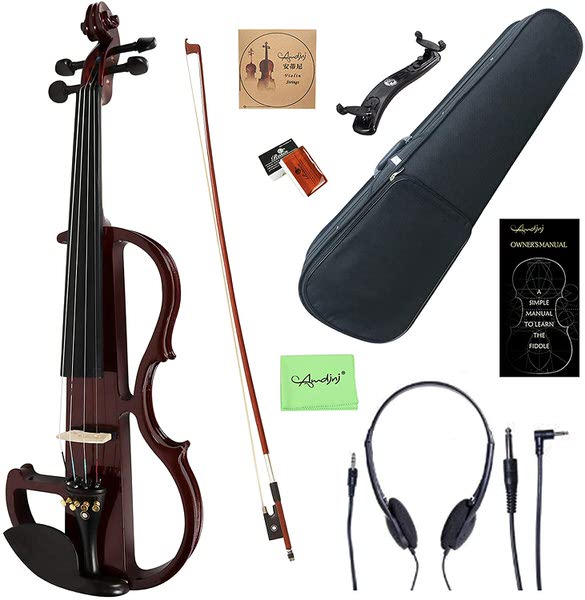
Some electric violins are sold in kits with everything such as this one on Amazon from Amdini. I won’t recommend that kit at all because, for the price of a set of strings, you get a violin, a bow, a shoulder rest, a set of strings, headphones, a case, rosin, and… a guide on how to learn the fiddle! The Italian-like name won’t make any miracle, I am sure! But it gives you a good overview of what is needed to play an electric violin.
Is an electric violin good for beginners?
I have discussed in detail how a beginner can start with an electric violin in this blog post. It can be detrimental if you want (for yourself or your kid) to have a classical career, take exams and make it to a symphony orchestra. In that case, the violinist needs to start with an acoustic classical instrument. In many other cases, it is perfectly possible to start with an electric fiddle.
If you want to play in a band
If you want to play in a band, it is perfectly fine to start with an electric fiddle. You will get used to the instrument you intend to play, right on. You will improve your sounds, your effects, be able to record yourself, experiment with your amp…
If you need to play silently
If you can’t be loud, then practicing with a silent instrument (see above) is a good solution. You will be able to practice everywhere with your new instrument without disturbing your family and friends. You will be more confident when practicing knowing you are unnoticed.
I remember, when I was young, I have developed the bad habit of playing too softly on my violin. My sound wasn’t good enough. I was afraid to apply pressure on my bow to practice unnoticed.
Is an electric violin a good first instrument?
Let’s be honest: yes if you like the fiddle. But it won’t make it an easy instrument. It will alleviate the main difficulty of a scratchy and squeaky sound, a bit, and protect you from a loud beginner sound. Certainly, you will be able to enjoy and treat yourself with a good rock or alternative sound right on. But expect a (less) steep learning curve, still. I am sorry. But now that you know everything, you shouldn’t be discouraged. So yes it is a good way to start the fiddle, but it is not a magical shortcut to stardom!
Why do electric violins have 5 strings?
A five-string electric violin has a lower C string, a fifth lower than the lowest string of a traditional violin.
Historically, there used to be two separate instruments:
- the violin with a range between G to E,
- the viola, a fifth lower, with a range between C to A.
To be amplified, each instrument needs to resonate in a natural resonating box. As resonance is naturally around one frequency only for a given object, it is a feat that a small wooden box (a violin) can amplify so greatly and beautifully so many different frequencies.
But not to the point where the same resonance chamber can be great to lower notes (C) to the upper register of the E string.
So the viola is bigger, heavier, longer has heavier strings, and is designed to have a great tone and timber for the lower register.
But as electric violins don’t have a resonance chamber, tones and frequencies are adjusted electronically on the amp and the recording computer. So it is easy just to add a string: you gain a bigger register with no real drawback other than some getting used to it.
A five strings electric violin has the same size as a four-string one. The low C string is then specially made for violin and is not just a viola string, which would be too long and big.
SO, with a fifth lower string, an electric violin goes to electric guitars, piano, or tenor saxophones territory without the traditional problems of sound being too low for the size of the instrument. So it’s a win-win deal for the electric violinist.
Do electric violins need special strings?
The short answer is: no.
I have described in length how electric violins work in that post. You can refer to it if you want.
But electric guitars have metal strings because they have magnetic pickups. Electric violins amplify the vibration of the bridge (or body in some cases) with a piezo microphone. They are designed to pick up the vibrations of the wood as opposed to the differences in the magnetic field around the string. That is why a piezo mike can amplify nylon strings as well as gut strings, synthetic core strings… as long as it vibrates the bridge.
So an electric violin will accommodate any type of string. I do not typically play the most expensive synthetic core strings on my Yamaha as I am not sure that they make such a difference when so much in tone and projection is due to the amp in an electric environment. I use Thomastik Dominant strings and find them perfect for my SV100 and SV255. I don’t play metallic strings, though, even if they have a good bow response.
As I have detailed above when addressing the question “how do electric violins have 5 strings”, the lower C string of a five-string electric violin is made for violin and not for viola; so in that case, it can be called a “special” string.
Do you need rosin for an electric violin?
Yes, you do. As all strings instruments, the violin produces its sound when the bow strikes the string with the microscopic scales of the bow hair, in conjunction with the stickiness of the rosin.
Without rosin, the bow wouldn’t vibrate the string at all, in the same way, an acoustic violin wouldn’t make any sound either. And without a sound to start with, there wouldn’t be anything to amplify; so electric violins make no exception: you need to rosin your bow properly (I explain here how to!).
Without rosin, your violin doesn’t work: it appears to be broken. If you have just bought your brand new electric violin, chances are the bow is not rosined at all, and your instrument won’t make any sound. I have covered many details on what to check to get your electric violin in working condition.
The gear and products I use and recommend for my electric violin
First, If you want to hear your electric violin, you need to either use headphones, plug it into an amp, or an audio interface.
The small amp I use and recommend if you want to practice at home is the great Yamaha THR10 from the THR series. It is portable and not expensive, easy to use and set up.
If you want to record yourself or plug your violin into headphones, your laptop, or your phone, a good and cheap digital audio interface I can recommend is the iRig HD2, which is more and more affordable on Amazon.
I typically use Thomastik Dominant strings on my electric violin. They come quite cheap on Amazon considering their quality and sound. Synthetic core strings work well on Yamaha electric violins.
Lastly, I use mainly Dominant rosin as well on my electric violin, as it has been designed to go with Dominant Strings.
You can check out in detail all the stuff I have tested and used on my recommended product page where I go into more details.

